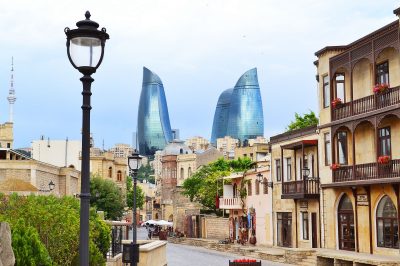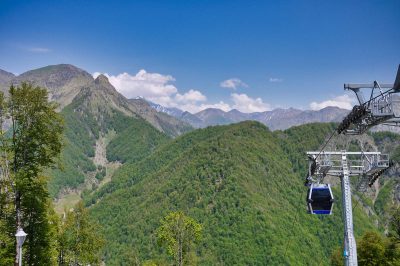In our travel blog we have already presented many countries. However, Azerbaijan might be the most exotic of them so far. The land of fire can look back on a rich historical past. With its medieval bazaars, caravanserais, mausoleums, palaces and mosques, it still looks a bit like a fairy tale from 1001 nights. But you can also experience the modern contrast here. The metropolis of Baku was the richest city in the world around 1900 because of the oil found here! Numerous magnificent villas from that time have been preserved, which have been joined by modern glass towers in recent years.
These are the most beautiful Azerbaijan sights
Reasons enough to pay a visit to Azerbaijan. To get you in the mood, here are the top 10 most beautiful Azerbaijan sights.
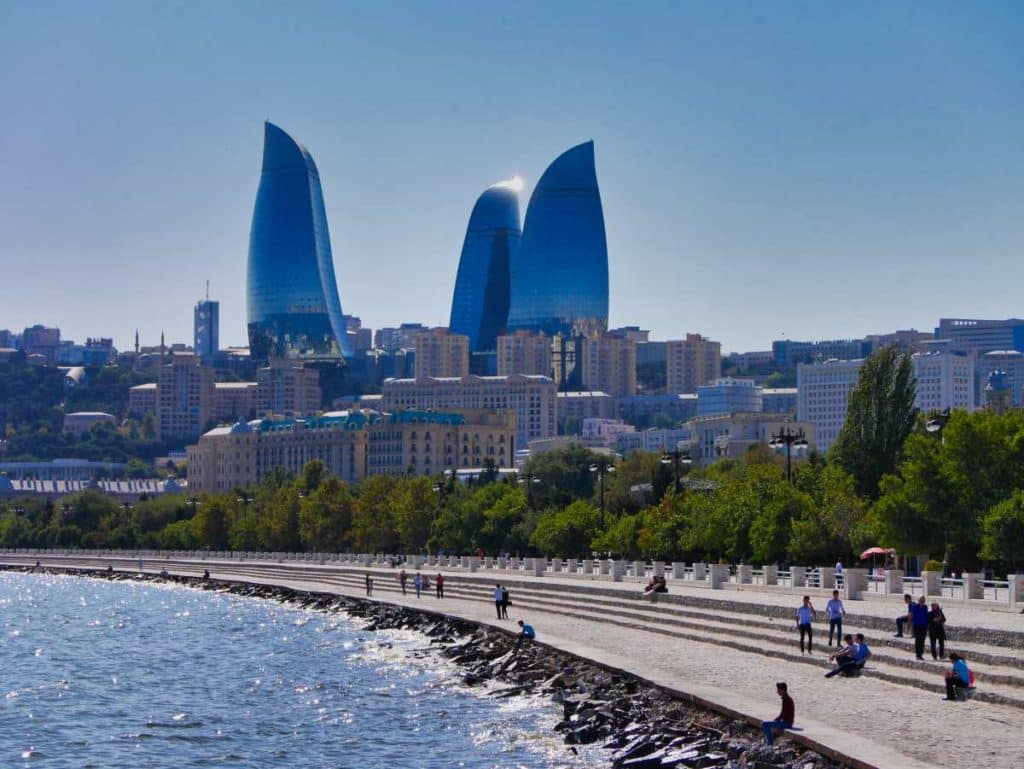
Baku
The heart of Azerbaijan beats in the country’s capital, Baku. The alleys of the UNESCO-protected and completely preserved Islamic Old Town hide all kinds of treasures, such as the Şirvanşah Palace, the Maiden’s Tower and the Marionette Theater. Architecturally, the city of two million people impresses with its amalgam of unique Art Nouveau villas from the oil boom era, centuries-old mosques, magnificent Soviet buildings and modern glass palaces.
Towering above it all are the three glass flames that serve as the new national symbol for the Land of Fire and one of the newest things to do in Baku, glowing at night in the colors of the Azerbaijani flag. A bit of a Bollywood feel wafts through the City of Winds, where you can dine royally, dance casually, relax in the hammam, listen to mugham music, stroll along the Bulwar, gondola through Little Venice, and walk in the footsteps of Ali and Nino.
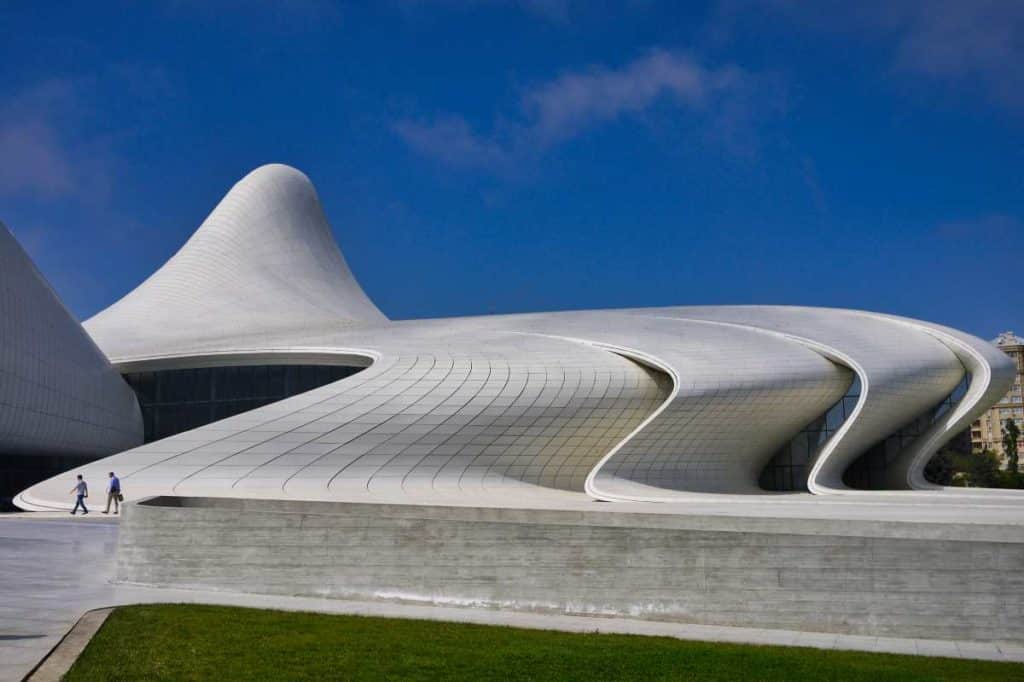
Heydər Əliyev Center
The spectacular exhibition center in Baku, designed by Zaha Hadid, offers a variety of great exhibitions and is a photo motif in a class of its own. In the organic white giant fish you will find on 60,000m², among other things, the permanent exhibition “Mini Azerbaijan”, in which there are 50 lovingly recreated miniature buildings from all over the country on a scale of 1:33 to see. The center is one of the most important cultural venues in the country and was named after the former president of Azerbaijan.
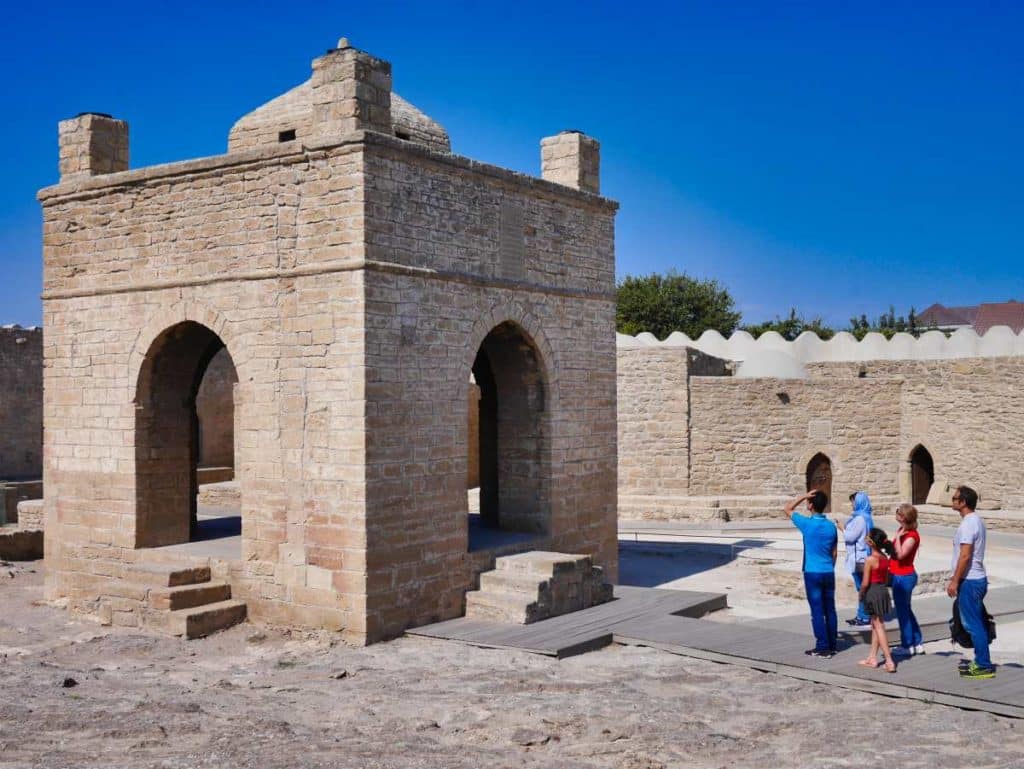
Suraxanı Fire Temple
The Abşeron Peninsula has a lot of interesting things to offer besides Baku. The Zoroastrian fire temple Ateshgah was built in the 17th century as a monastery complex and recently restored. Comparable temples can only be found in Iran and Georgia. Also worth seeing is a natural gas fire burning since ancient times on the slope of a hill called Yanar Dağ, which is definitely worth a side trip. Fire is a symbol of light, warmth and protection from evil spirits in the land of fire (“azer” means fire).
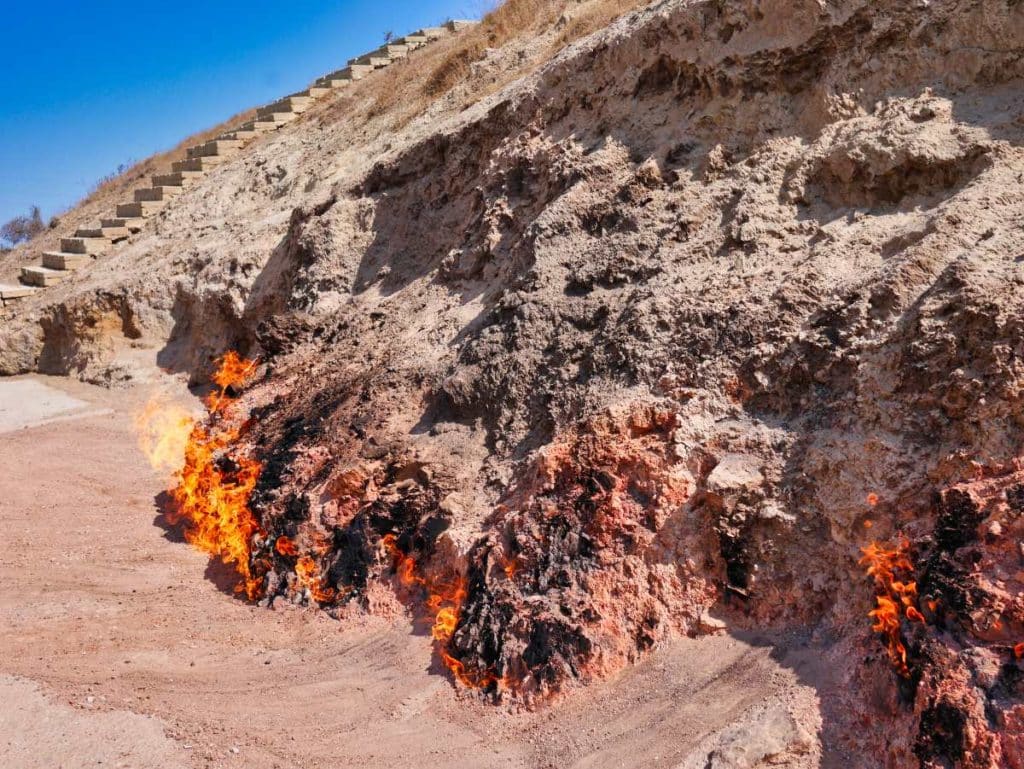
Qobustan
Surrounded by seething mud volcanoes lies the 500-hectare Qobustan National Park, in the center of which rises the rocky area of Beyukdash Mountain with 6,000 Stone Age petroglyphs. Since 2007, these filigree line drawings, some of which are 5,000 years old, and are called petroglyphs, 70 km southwest of Baku, have been a UNESCO World Heritage Site. They were first discovered in the 1930s. In the museum of the “rock of ages”, which belongs to the area, there are enlargements of the drawings and further explanations. On the way back to Baku, we recommend a stop at the Bibi Heybat oil field, which served as the backdrop for the James Bond film “The World Is Not Enough”.
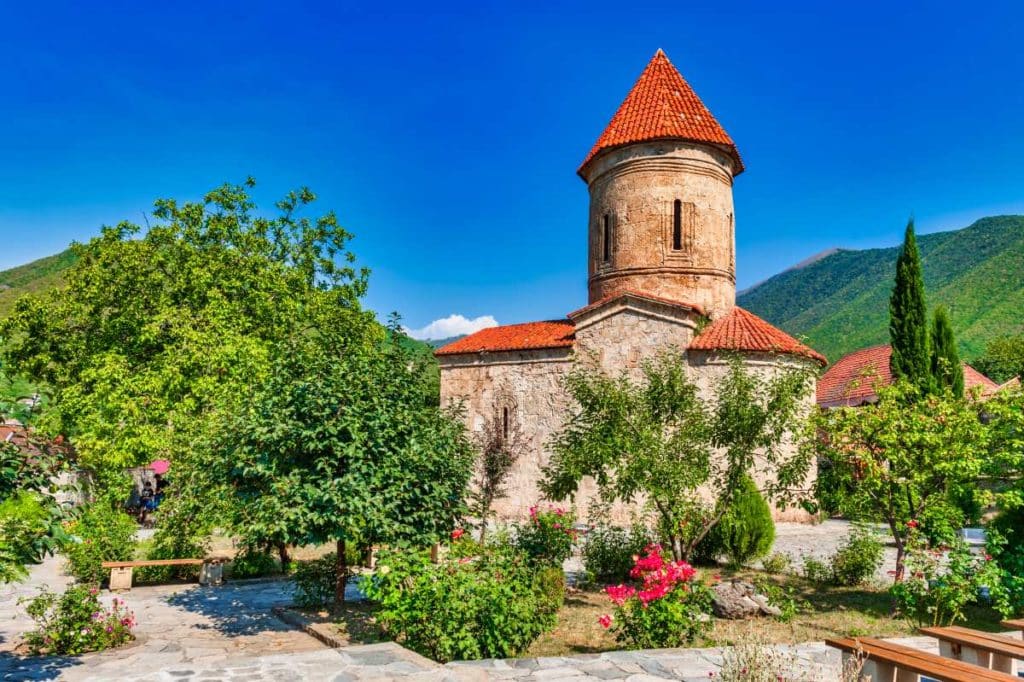
Şəki
On the Georgian border on the Great Caucasus lies picturesquely the 2000-year-old Silk Road town of Şəki with the UNESCO-protected Khan Palace and the three mystical caravanserais from the 18th and 19th centuries, one of which now functions as a hotel. Once the largest silk factory in the USSR, it is still in operation and offers visitors unexpected behind-the-scenes glimpses and first-hand souvenirs. A palace tour immerses visitors in the bright colors of the so-called Schebeke windows, whose colored glass mosaics are held together by wooden struts. Originally Murano glass was used, which was traded for silver and spices on the Silk Road. Today’s glass comes from Germany.
Gəncə
Vineyards and silkworm breeding characterize the extensive valleys of Azerbaijan’s second largest city, which is easily reached by night train. In the Middle Ages, the more than 200-year-old city was an important trading center and home to the universally revered poet Nizami, whose memory is commemorated with a marble mausoleum. From Gəncə you should visit the former German settlements of Göygöl, Tovus, Şəmkir and Çınarlı with their authentic, freshly renovated half-timbered houses. In 1920, the winegrowers’ cooperative “Konkordija” was founded by Swabian pietists. Guided tours are offered in Kedabag, where you can follow in the footsteps of the Siemens brothers, who promoted copper mining and built aqueducts there. Not far from Gəncə, wellness oases invite you to take oil baths, whose healing effects were already described by Marco Polo. The once chic spa is not called Naftalan (from neft for oil) for nothing.
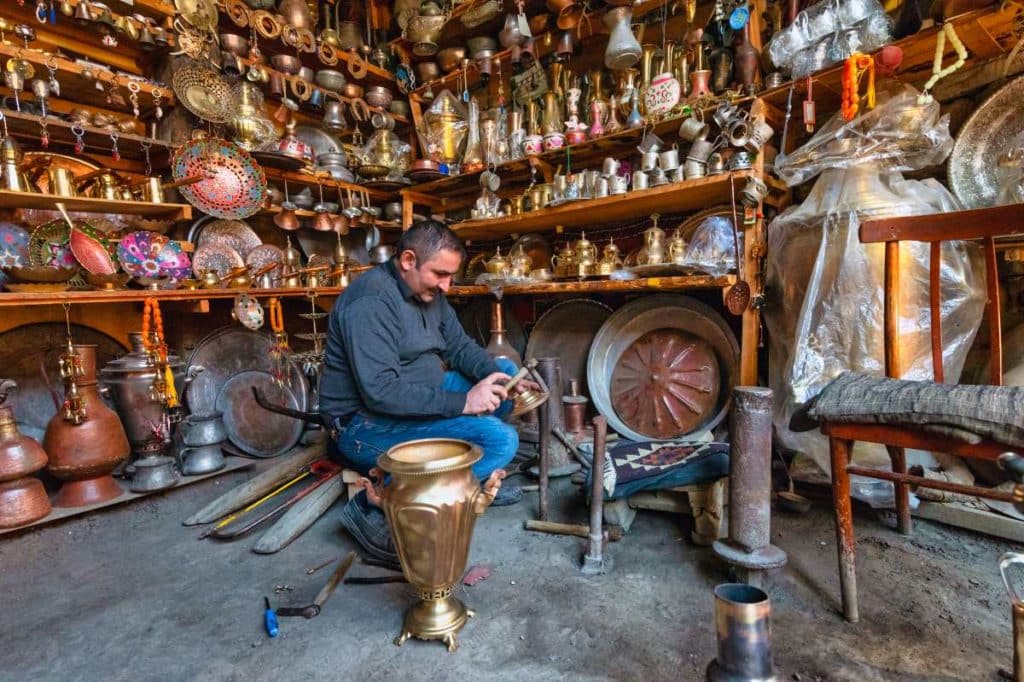
Lahic
In northwestern Azerbaijan lies the small mountain village of Lahic at an altitude of just under 1400 meters. It is known for its coppersmiths, where jugs and samovars are still made. The vessels made there, as well as weapons and jewelry, were transported from Lahic to the bazaars on the Silk Road at the time. Since 2018, there is a well-built road to the remote area, whose plains with castle ruins and waterfalls are wonderful for long hikes on foot or on horseback. The former collective farm village of Ivanovka is worth a detour. Here honey is produced and Russian is spoken.
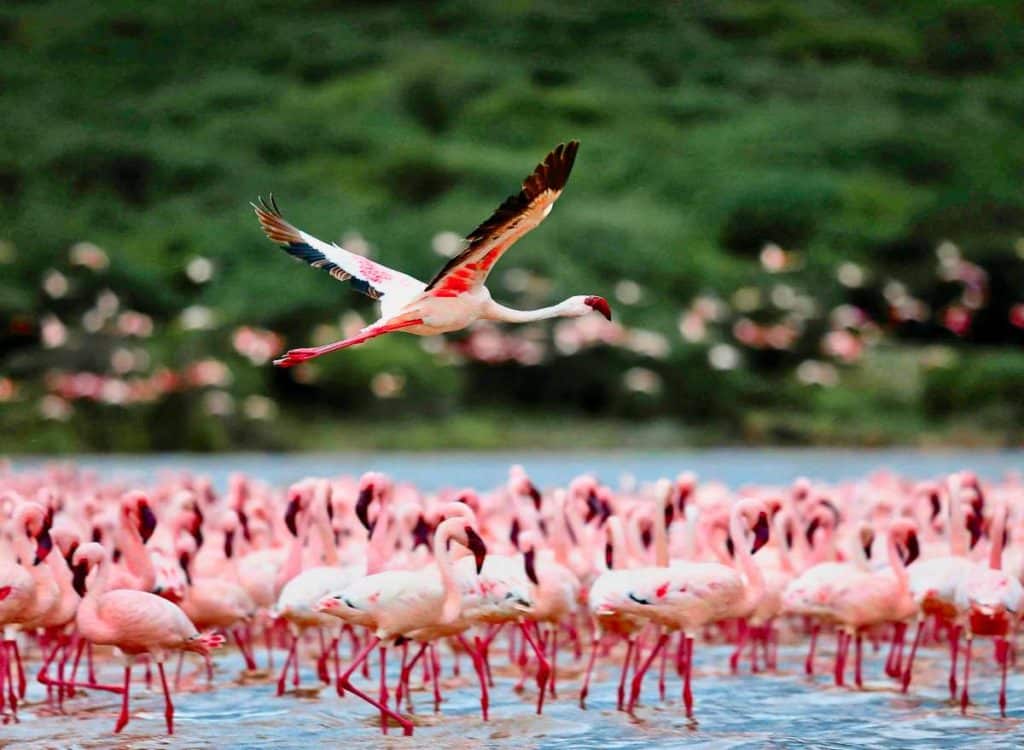
Lənkəran
In the subtropical climate on the Caspian Sea in southern Azerbaijan, tea and tropical fruits thrive on plantations stretching to the horizon. However, silk and carpets are also produced in large numbers in the Talış region on the Iranian border. In this biodiverse stretch of land, lagoons with flamingos, untouched steppe landscapes and the Hirkan National Park, where there are still real primeval forests and 150 different species of woody plants to be seen, are inviting. However, you will not see the Caucasian leopard, which lives in a separate part of the park.
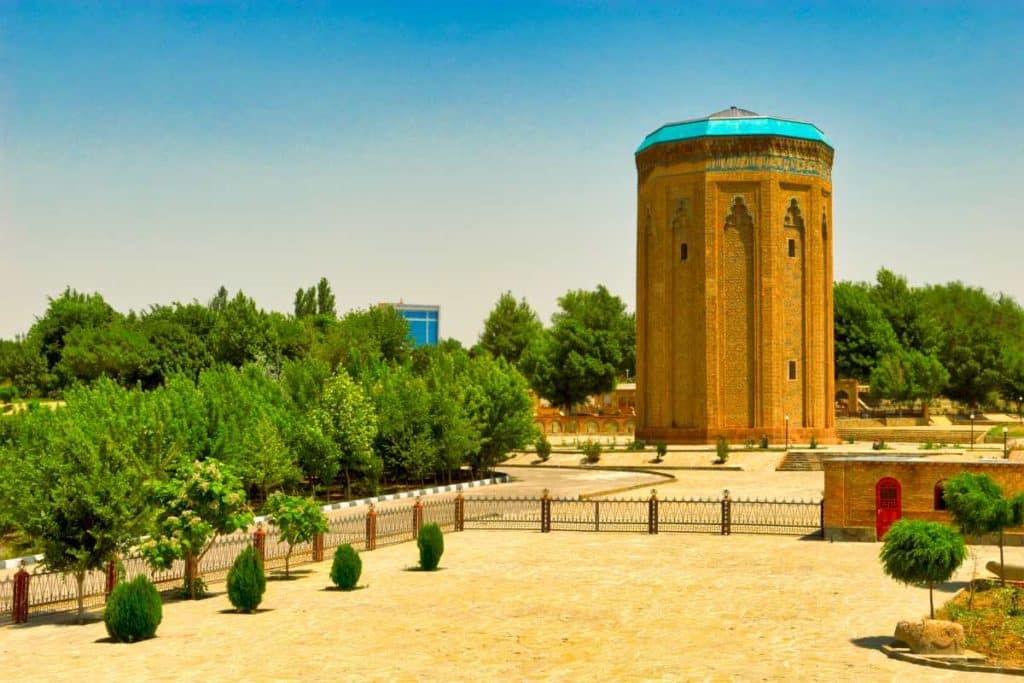
Naxçıvan
In the Autonomous Republic of Naxçıvan in the west of the country, the clocks tick differently. This little country is known as the “Switzerland of Azerbaijan”. Promoted by Lonely Planet as “the world’s most sustainable nation,” the breathtakingly beautiful mountainous enclave is an almost unknown paradise. The area between Ararat and Ordubad is home to the “Machu Picchu” of Eurasia, the Tomb of Noah and the oldest salt mine in the world. When it is already winter in Baku, the sun is still shining here. The capital Naxçıvan City was the Islamic Cultural Capital in 2018. The train line is currently being reactivated so that in the future it will be possible to travel there directly from Baku.
Nabran
The most popular seaside resort in Azerbaijan is suitable for relaxation, especially during the week. You can swim in the Caspian Sea, but not surf. The waves are not high enough for that. The adjacent 11,000-hectare Samur-Yalama National Park advertises that the 30-kilometer-long but rather narrow beach here merges into dense forests. Hiking is also a great pleasure in this region of Azerbaijan. In the meantime, there are already designated and licensed hiking routes. In the long term, Azerbaijan is focusing on eco-tourism and, in this context, plans to convert 11% of the country’s territory into national parks.
Book recommendations
Everything you need to know about Azerbaijan’s troubled past, presented in a nutshell.
- Johenning, Heike Maria (Author)
You want to know more about Azerbaijan’s culture? Than this book is the right choice!
- Heike Maria Johenning (Author)
Classical travel guide, that also covers Armenia and Georgia.
- Holger Kretzschmar (Author)
To prepare your trip, it is best to learn a few words in Azerbaijani. This book is great for beginners!
This compendium should probably contain pretty much all the dishes that exist in Azerbaijani cuisine. Wonderfully designed and over 800 pages strong!
- Said, Kurban (Author)
Portrait of Azerbaijan, presenting the country in all its facets.
What is the most beautiful of all Azerbaijan sights for you? Let us know and write us a comment! And make sure to follow us on Facebook for more articles!


